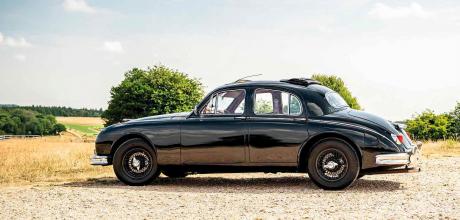1959 Jaguar 3.8 Mk1
This Jaguar Mk1 has been developed to a high pitch over the last 27 years of ownership. And it became a crime-busting TV star on the way, as Robert Coucher discovers.
Photography Barry Hayden
MORSE’S FIRST JAGUARONE MAN’S ENDEAVOUR
THE OTHER MORSE JAGUAR
Not the lugubrious detective’s famous Mk2, but young Endeavour’s more discreet Mk1
You know when you spot a really good motor car at 50 yards. I don’t mean some flashy, over-restored boiled sweet; I mean a car that is honest, straight and clean, and the demeanour and stance of which tell you that it’s a well-sorted piece of kit that’s going to be good to drive. I was at Jaguar specialist Twyford Moors in Hampshire a couple of months ago and spied this attractive Jaguar Mk1 parked on the forecourt. So I went and introduced myself to the owner. It turns out that Anthony Gilsenan has been the custodian of this 1959 Jaguar for 27 years and has subjected it to a continuous, rolling restoration. Ah, a long-term, committed owner – this sporting Jaguar is probably going to prove even better than it looks.
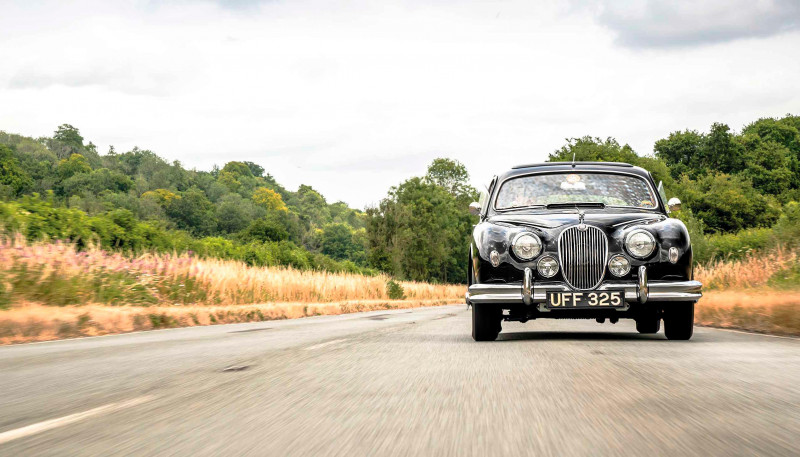
‘I took it to Roland Stoat for the bodywork. He found that the driver’sside floor was made of glassfibre’
Sir William Lyons was in the motor manufacturing business to make money. He was a notorious penny-pincher, cutting costs wherever he could. That meant he produced motor cars at affordable prices, but his real genius was that the cars were beautifully styled and extremely well engineered. Motor racing, Le Mans success and sexy sports cars grabbed the headlines and were all good fun, but Lyons’ mission was to produce in volume and the saloon car segment was where that lay – compact, aspirational saloons aimed at the burgeoning middle-class driver.
He’d had success with Jaguar saloons since the late ’30s, cars such as the 1.5, 3.5 and later 2.5-Litre and the huge MkVII, but with the arrival of the Jaguar 2.4 saloon in 1955 (the Mk1 nomenclature was used retrospectively after the Mk2 appeared in 1959) he introduced another game-changer for Jaguar: unitary construction. The 2.4, joined by a 3.4 in 1957, was the first roadgoing Jaguar freed from an old-fashioned separate chassis.
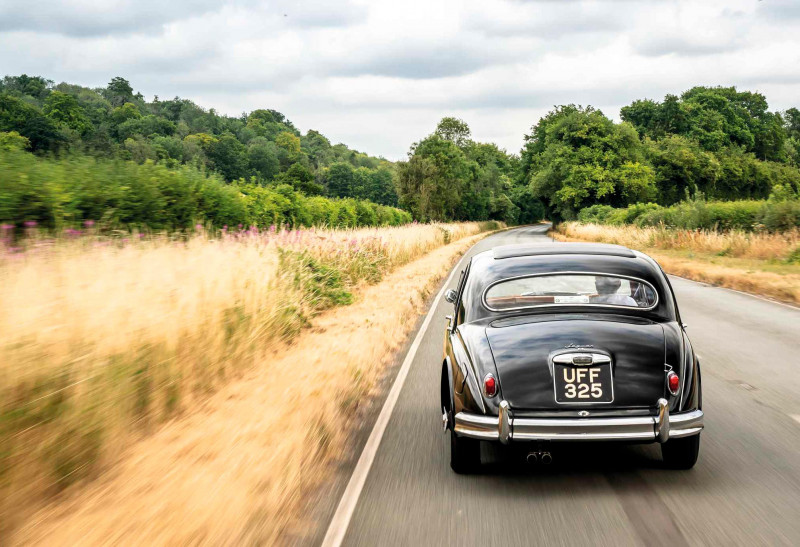
Attached to the modern, light and compact structure was independent front suspension featuring double wishbones, coil springs, telescopic dampers and an anti-roll bar, all carried in a separate subframe mounted to the body by rubber bushes to insulate the occupants from noise, vibration and harshness. It was not a solution unique to Jaguar at the time, but it was an effective, even world-class, refinement tool that reached its zenith in the XJ saloon that was voted Car of the Year in 1970.
‘The young actor Shaun Evans, who played Morse in his early days, took to the Jaguar with ease and drove it well’
The rear suspension was a simplified development of the D-type’s, featuring inverted semi-elliptic springs cantilevered into the main body frame, with the rear quarter section carrying the live axle and acting as a trailing arm. A Panhard rod took care of transverse forces. It was a clever arrangement, which used simple components and relieved the rear bodywork of torsional stress.
One anomaly, though, was rear track a hefty 4.5in narrower than at the front. The marketing blurb told us that a narrow rear track helped high-speed stability, but it did look peculiar. More likely, reckoned insiders, was that Lyons bought a job lot of Salisbury rear axles of a given size and got his engineers to make them fit (badly) into the rear of the Mk1.
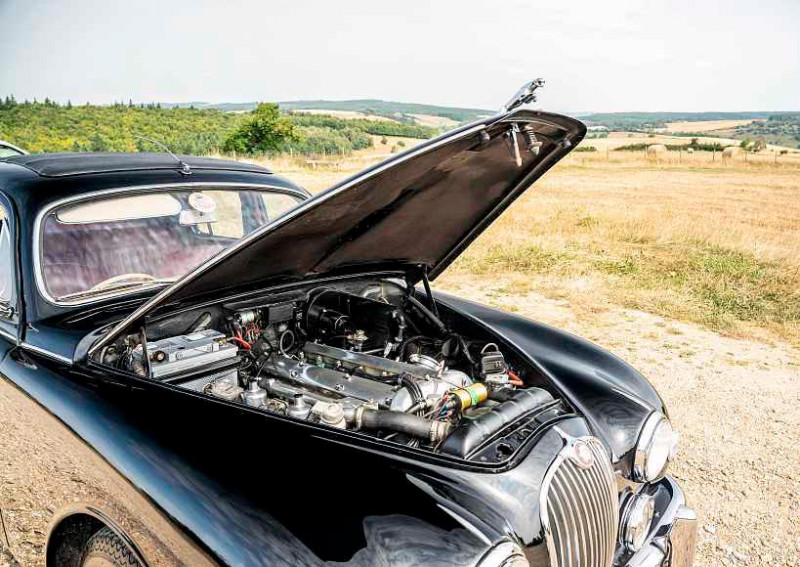
Drum brakes slowed the first Mk1s, but Jaguar’s famous, race-proven discs-all-round arrived in 1957 to seal the Mk1’s reputation as a fast, secure and comfortable sporting saloon. Grace, space and pace, indeed. The Jaguar was a true 100mph machine in 3.4-litre form, well able to blow the doors off the then-current Humbers, Rovers and Standard Vanguards. Even more remarkably, it could stay with sports cars such as Jaguar’s own XK 140 while offering room in the back for an extra two adults. No British saloon had managed this before.
The Mk1 was effective both on the racetrack and as a rally weapon. It was driven by the best, including Stirling Moss, Mike Hawthorn (that ended badly), Tommy Sopwith and Roy Salvadori, cementing Jaguar’s racing prowess while selling in good numbers to the fast fellows in the growing number of affluent suburbs. Then, having sold a little over 35,000 Mk1s to enthusiastic press-on drivers, Jaguar unveiled the Mk2 in 1959. It was an evolution with more glass area, a more modern dashboard and a back axle of the correct width. And then sales of Jaguar’s compact saloon really took off.
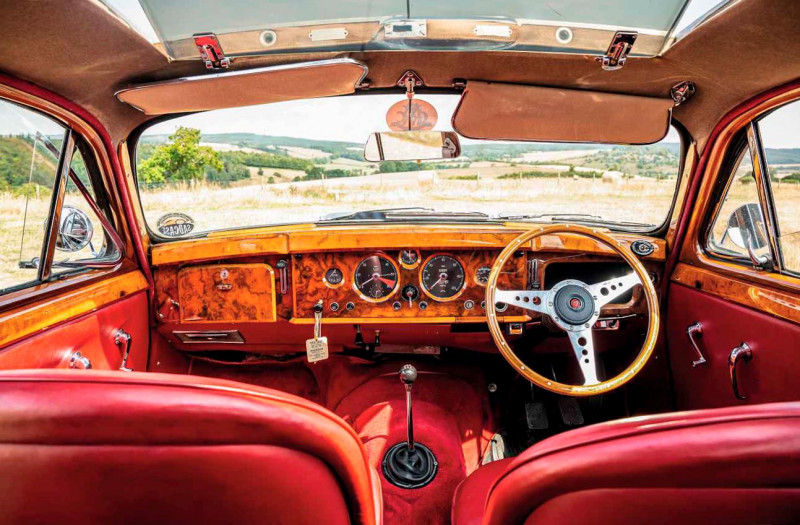
His background is in engineering, but Anthony Gilsenan’s career is in advertising, marketing and PR. Naturally, then, he had to have a suitable Mad Men motor car. ‘I had the first Beacham Mk2 [a restomod from New Zealand]in the UK, followed by another Mk2. But I always wanted a Mk1, a much rarer model with looks that I prefer. I found this car advertised at a London dealer in 1995 and it looked good in black, so I bought it.
‘It was fitted with a 3.8-litre engine from a Jaguar S-type, along with an all-synchromesh geabox with overdrive. It was certainly fast but unfortunately the bodywork was in a poor state. So began the long restoration. I took the Jaguar to Roland Stoat at RS Coachworks in Berkshire to have the bodywork done. He found that the driver’s-side floor was made of glassfibre. He did a super job including the sills and the rear spring hangers, and fitted correct spatless rear wings, which were properly rolled and lead-loaded. I then fitted wire wheels.
These are now the second set from Motor Wheel Service International, and I think they look great in black to match the body colour. ‘Over the years I have done pretty much everything. The underneath is Mk2, including the front subframe, suspension, disc brakes and a limited-slip diff. It runs on Koni Classic dampers, which are great, along with a thicker front anti-roll bar to tighten up the handling. The clutch is hydraulic and the brakes are servo assisted, so it really stops. The 3.8-litre engine has been rebuilt to standard spec but it does have a special exhaust made by the chap who produced racing exhausts for John Coombs. I absolutely love the sound it produces.’
And so it continues. Clearly Anthony has invested a good deal of time and money in UFF 325, but it’s the careful honing and detail improvements that indicate more than just maintenance. This is heart-and-soul stuff. Polybushed suspension, of course. High-torque starter motor, naturally. New radiator and efficient electric fan, certainly. Complete retrim in soft red leather, beautifully done. LED dashboard lightbulbs, why not? E-type seatbelts, just the job. He has also fitted neat rear-view mirrors on each side, added sound-deadening liners to the doors, and affixed a 3.8 badge to the boot-lid. And the Jag absolutely has to have that natty roof aerial and Webasto sunroof with visor, to add the final flourishes. ‘One Christmas I had some quiet time, so I decided to strip and re-varnish all the wood veneer in the cabin,’ says Anthony. ‘The wood was slathered in a thick yacht vanish and looked rather crude. There are 27 individual pieces that make up the interior, so there was quite a lot of rubbing-down and varnishing to be done,’ he laughs. The result is superb, set off by the red leather upholstery and the gleaming black paintwork.
‘I did fit a set of Harvey Bailey front springs and an anti-roll bar, but the springs proved to be too harsh so I dialled back to standard Mk2 springs, which are better-suited to my road use. I have thought about power steering, but the wood-rimmed Moto-Lita steering wheel works effectively if you wear leather gloves. They increase grip enormously. Also, the Blockley radial tyres recently fitted lighten the steering weight enormously, so the lack of power steering is not an issue.’ This 78-year-old is clearly in excellent shape.
It’s obvious that Anthony is a bit of an entrepreneur as he chats about his business interests and other things. ‘Once I’d restored the Mk1 I realised its black paintwork and red interior would be an ideal mobile backdrop for a bride’s white dress, so I set up a wedding-car business. I’ve been doing it for years and it has more than paid for all the work the car has needed. It’s been fun to invest in the Jaguar and I enjoy driving a beautiful bride to the church. And the newlyweds always enjoy the Jaguar.
‘Then, about ten years ago, a television production company contacted me. They’d heard I had this black Mk1 which they wanted to use as a police car in the first Endeavour television programme, featuring Inspector Morse as a young man. They made up new numberplates and a police sign to mount on the radiator grille, and we began seven days of filming in and around Oxford. I had to be on standby with the Jaguar.
‘The young actor Shaun Evans, who played Morse in his early days, took to the car with ease and drove it really well. Unfortunately, Roger Allam [playing Detective Inspector Fred Thursday] had the habit of slamming the front door shut. On one occasion he slammed it so hard the window glass came down and stuck. With 37 people on set I had 15 minutes to remove the door trim and get the window back up again. Some pressure.’
We meet at Glorious Goodwood on a lovely sunny day to take photographs. Not Oxford as in the Endeavour series, but Anthony’s home turf where the B-roads perfectly suit the Jaguar’s mien. He hands me the diminutive ignition key and suggests I have a drive. I must confess I’m a sucker for a Mk1 Jaguar. It appeals to me more than the slightly blinged-up Mk2, especially with all the period upgrades on this example – specifically the wider rear axle and beautifully turned rear arches.
I sense Anthony is a little nervous about letting me drive his well-loved motor car, so let’s be gentle. The 3.8-litre engine fires instantly thanks to the high-torque starter motor and the well-tuned, original-spec 1¾-inch SU carbs. The engine feels sharp, responsive and light of flywheel. The twin-pipe Coombs exhaust is a little naughty, but nice. The red leather seat is by no means a ‘bucket’, more a softly sprung chair, and the hydraulic clutch feels firm. I make a bit of a hash of finding first gear as the rubbery gearlever linkage requires a bit of learning. As I wind it up through the gears and into overdrive top, my immediate realisation is how much more refined this unitary body is over the separate chassis and body of the preceding XK models. This ground-breaking Mk1 is significantly more genteel: it’s quiet, the body feels taut, the suspension mounted on the rubber-bushed subframe is pliant and the solid rear axle is subdued over transverse ridges. UFF 325 feels much younger than its 63 years thanks to both its innate design quality and Anthony’s committed attention to detail.
Picking up some speed on the B2146 and B2141 between Petersfield and Mid Lavant, one of the finest road sequences in southern England, the Jaguar starts to reveal its depth. This engine is just marvellous. I’m not sure what has been done to its innards but it revs with gusto. All the while the Mk1 feels neat and tidy on the road. The worm-and-peg steering is a bit vague around the straight-ahead position, but once you’ve got a bit of lean on early in the corners to add weight to the steering, the slack is eradicated and it sharpens right up.
The initial understeer and the entry/exit angles are very simply and enjoyably controlled by the throttle, aided and abetted by the (again slightly naughty) limited-slip differential. This really is the ‘right stuff’. I can feel Anthony beginning to relax so I squirt the Jaguar through a sequence of corners with good sightlines. God, this is fun. The Jaguar just wants to drift and dance, its engine zingy, the suspension taut, the body tight, the exhaust note full of bravura at high revs, the brakes immense. I could tell from 50 yards that this 3.8-litre Mk1 was going to be good. From the driver’s seat it’s even better, thanks to the heart and soul that Anthony Gilsenan has put into this fabulous Jaguar over the 27 years since he saved it from ruin. One man’s endeavour, indeed.
THANKS TO Twyford Moors, wwwjagxk.com. And if you need a smart wedding car, contact Anthony at www.agclassicweddingcars.co.uk.
‘Anthony relaxes, so I squirt the Jaguar through a sequence of corners with good sightlines. God, this is fun’
Clockwise from above Coucher and owner Gilsenan peruse the Morse-themed press cuttings; ‘Police’ marking is discreet but menacing; South Downs replace Oxford for today’s production of twin-tailpipe music. Facing page The Mk1, on film duty with different numberplates, meets siblings at a fictional used-car lot; Roger Allam, aka DI Fred Thursday, looks rueful after slamming the door and causing the window to disappear inside.
TECHNICAL DATA 1959 Jaguar 3.8 Mk1
- Engine 3781cc straight-six, DOHC, twin SU HD6 carburettors
- Max Power 210bhp @ 5500rpm
- Max Torque 216lb ft @ 3000rpm
- Transmission Four-speed manual with overdrive, rear-wheel drive
- Steering Worm and roller
- Suspension Front: double wishbones, coil springs, telescopic dampers, anti-roll bar.
- Rear: live axle, cantilevered leaf springs, Panhard rod, telescopic dampers
- Brakes Discs
- Weight 1380kg
- Top speed 120mph
- 0-60mph 9sec
MORSE’S FIRST JAGUAR
This page and opposite S-type 3.8 has ousted original Mk1 motor; rolled, spatless rear ’arches and a Mk2’s wide axle signal underlying potency; central dials inhabit super-shiny dash; red interior goes well with a white wedding dress.


